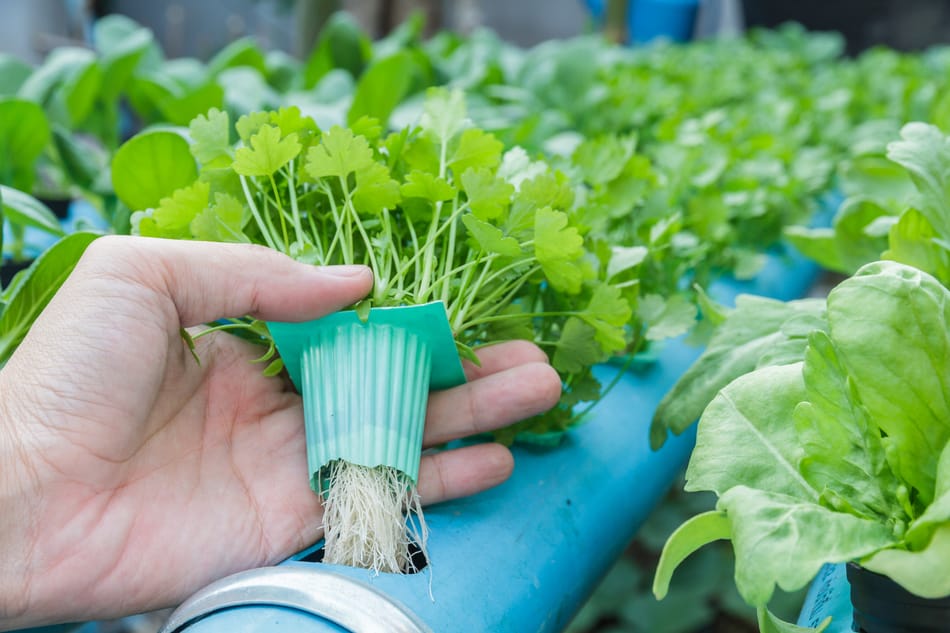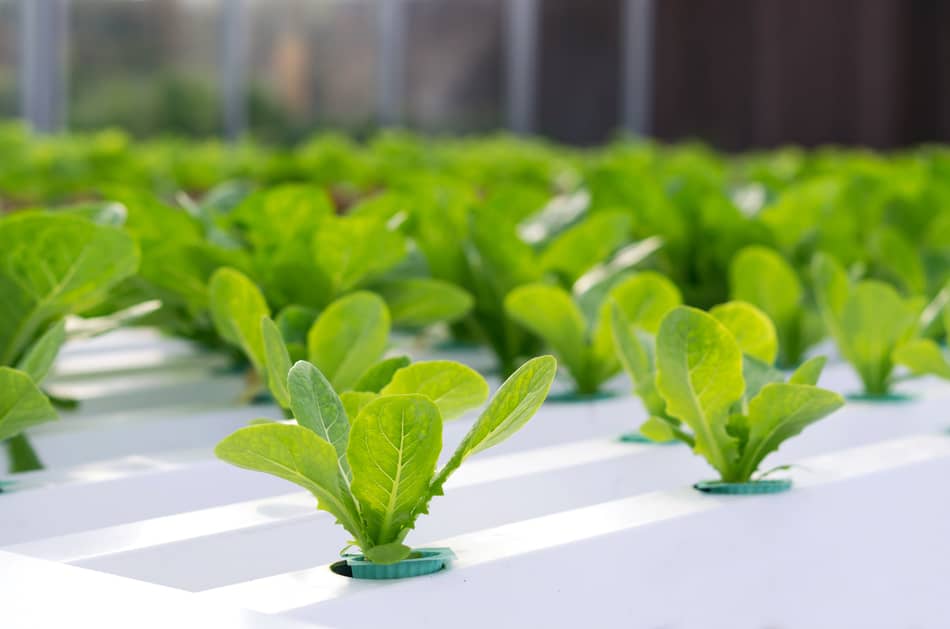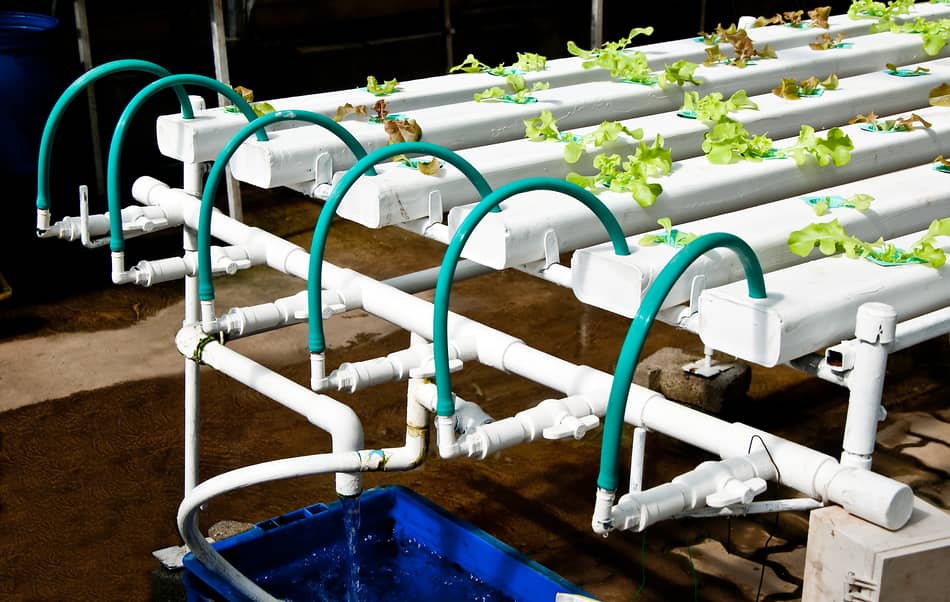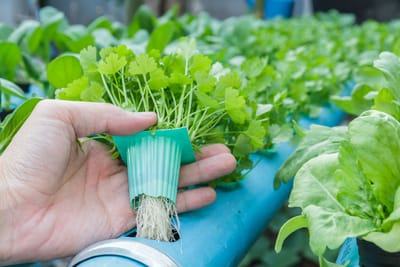A common question gardeners ask is whether to use supplemental nutrients, and if so, when & what nutrients to use. It’s one of those questions where the answer is: “It depends.” But I’ll give rules-of-thumb you can use. Every plant is different, so deciding when to begin using nutrients will be different for each plant.
Nutrients aren’t needed for seedlings until the seedlings grow their first set of true leaves. Since the seed contains enough nutrients for the plant to survive germination. In most situations, it’s best to test your soil to see if you need to add nutrients to the soil before you plant the seeds.
You might also want to read more details about how plants grow in water vs. soil.
 Seedling plug in hydroponics
Seedling plug in hydroponics
About plant nutrients and seedlings
I like to think that plant nutrients are similar to a multivitamin.
Like a vitamin, nutrients help plants grow strong and healthy, fight off disease, and help the plants reach their peak performance.
The main nutrients that plants need are nitrogen, phosphorous, and potassium–also known by their element symbols: N, P, and K.
Micronutrients are also needed for plant health but in smaller amounts than nitrogen, phosphorous, and potassium.
Each plant needs different nutrients and different amounts of those nutrients at different stages in their life.
The simple rule for when to seedlings need nutrients
As for when to start using them, a good rule of thumb is to start using them when your plant begins to grow its first true leaves.
The leaves that first sprout (after germination) on a seedling contain all the nutrients the seedling will need for the first few days of its life.
So, once you see the second set of leaves–the true leaves–you can use a diluted fertilizer until the plant gets bigger.
Start with a water soluble diluted fertilizer with the essential nutrients for your seedlings that you use once or twice a week.
You can play around with how often to give your plant nutrients, just note any improvements in your plant or any decreases in growth.
Signs of excessive nutrients
If you notice the following symptoms:
- leaves turning yellow,
- lack of new growth,
- wilting,
- or any salt build up in the soil–or salt residue in your hydroponic system
then you might be over fertilizing.
If you think you have been over watering your plant, you can try to flush the excessive nutrients out by watering the plant and letting the water drain so as not to drown the plant.
Before using any fertilizer, make sure you have not used any potting mix.
Potting mix has some nutrients in it already and if you add more nutrients you can hurt your plant with too much nutrients.
 Seedlings in hydroponics
Seedlings in hydroponics
Why use nutrients for seedlings
As your seedlings grow, they can use a little extra boost to help them grow big and have good future yields.
The addition of nutrients can help the seedling fight off future disease, especially when the seedlings are young and vulnerable.
Nutrients help the plants grow strong stems, fight off diseases, produce fruits, and produce leaves.
When using nutrients for seedlings, you should dilute the nutrients otherwise you may use too much nutrients and it can harm your plant.
You can do this by adding water to the fertilizer.
If you’re concerned about over fertilizing, another good option is to use potting mix.
Potting mix is soil that has some nutrients in it but is less concentrated than fertilizers so you run less of a risk of doing detrimental harm to your seedlings.
Make sure not to use potting mix and fertilizer because this will over fertilize your plants and can harm them or kill them.
By adding nitrogen, phosphorous, and potassium to your plants, you can make a good soil condition for them to grow in.
Other micronutrients such as calcium, magnesium, and iron also help with plant growth.
Unless you’re very concerned about a specific micronutrient for a specific plant, most fertilizers supply the main three nutrients (N, P, & K).
Types of fertilizers
Although most full grown plants need nitrogen rich fertilizers to help them grow big fruits, seedlings need a phosphorus rich fertilizer to help with stem strength and vegetation.
You should look for a fertilizer or potting mix with a higher phosphorus ratio while not depriving your seedling of the other essential nutrients.
The three main nutrients are nitrogen, phosphorous, and potassium–remember:
- N: nitrogen
- P: phosphorus
- K: potassium
so it’s important to not deprive the seedling of any of these nutrients.
Synthetic fertilizers
Synthetic fertilizer should be used weekly, diluted before using on seedlings. Synthetic fertilizer begins to work instantly when put in the soil or hydroponic system.
Synthetic fertilizers are an easy and convenient to use.
Synthetic fertilizers can have some negative effects on your soil by making the soil deficient in some naturally occurring nutrients.
For hydroponic systems, that’s less of a concern, since you have more control over the plants’ inputs.
Organic fertilizers
Organic fertilizers can also be used weekly, and should be diluted before using on your seedlings.
Fish emulsion is a nitrogen rich fertilizer that’s more mild than other fertilizers. It’s good for seedlings, because it replenishes the soil and helps nourish young plants.
Another type of organic fertilizers is compost.
Compost is something you can make at home, and is effective at giving your seedlings the nutrients they need.
One thing to consider with compost: do NOT use too much compost, since it can burn your plants.
Both synthetic and organic fertilizers are a good source of nutrients for your plants. It depends on the types of nutrients you want to obtain and the desired outcome you want to see.
If you want to have a quick fix for a stunted plant due to the lack of nutrients, a synthetic fertilizer is probably your best option.
If you want to prepare your soil for your future seeds then organic compost can be the best option.
Essentially, organic fertilizers like compost help condition the soil and are usually considered “slow-release” fertilizers, compared to synthetic fertilizers, which can provide a quick jolt of nutrients to plants.
 How Old Should Seedlings Be Before Using Nutrients?
How Old Should Seedlings Be Before Using Nutrients?
When to add nutrients to seedlings
If you’ve got a hydroponic system, and aren’t not sure if you should change the water, you can read a more detailed article on when to change water in a hydroponic system.
Plants can use nutrients at any stage, using nutrients about once or twice a week.
Young seedlings, when the plants begin to grow leaves, and when they begin to grow fruits are crucial times to get them the essential nutrients for maximum yield and health.
For seedlings, you should not use nutrients until you see the first true leaves.
You might need to use nutrients in the soil before planting the seeds if the soil is particularly lacking of nutrients.
Seedlings need diluted nutrients so that they are not harmed by high amounts of nutrients. For seedlings, use potassium rich fertilizers.
For the later stages, nitrogen rich fertilizers are important especially for fruit growth.
Depending on where your plants are will change how often you fertilize them. If they are in a container then once or twice a week should be sufficient.
For house plants, fertilize once a week.
For outdoor plants, fertilize once a month.
That’s because the natural nutrients in soil are more readily available. Outside, the soil is going to have more nutrients than inside.
It’s recommended to test your soil prior to planting seeds. That way, you can see the exact amount of nutrients currently in your soil.
Then, you can gauge what nutrients you need, how much of each you need, and how often to apply them.
Nutrient needs for common plants
Here is a guide to some of the more popular plants and when to start using nutrients:
- Tomatoes: Use a phosphorus rich fertilizer with less nitrogen when they’re first planted into a garden and when they begin to flower.
- Peppers: Peppers prefer fertilizer with a lower ratio of nitrogen after the first true leaves appear, when you transplant them, and when the fruits set.
- Broccoli: Use nutrients in the soil before planting the broccoli and about a month after planting.
- Carrots: Use nutrients before planting; if the carrot leaves appear pale, add a small amount of nutrients to the soil.
- Kale: Add nutrients to the hydroponic solution or soil prior to planting.
- Spinach: Fertilize every 2 weeks.
Related questions
What is the ratio for fertilizers?
The N-P-K ratio is the amount of nitrogen, phosphorous, and potassium in a fertilizer. So a 10-10-10 fertilizer has 10% nitrogen, 10% phosphorous, and 10% potassium. The fertilizer label indicates the ratio of N-P-K.
What is the difference between fertilizer and potting mix?
Fertilizer is a concentrated amount of nutrients but potting mix is soil with nutrients in it, but isn’t as concentrated. It’s important to differentiate between potting mix and fertilizer when deciding what to use for your plant. If you need a high dose of nutrients, then you should use fertilizer.
Should I use nutrients every time I water the seedlings?
No, only use nutrients once or twice a week. Adding nutrients more often creates a buildup of excess nutrients that can harm plants. Testing your soil or hydroponic solution weekly to make sure you have proper nutrient levels..
How long should you wait to water your plants after using fertilizer?
If you water your plants directly after using fertilizer, you can run the risk of flushing the nutrients out of the soil. So, wait a day before watering the plants so they can absorb nutrients.

